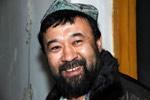Foreign and Military Affairs
He saved 20,000 Chinese in Nanjing Massacre
Updated: 2011-02-21 10:57
(Xinhua)
Addressing the ceremony, Xie Hangsheng, Chinese ambassador to Denmark, thanked Sindberg and his family and Denmark for their friendship.
"To us Chinese people, especially the people in Nanjing, he (Sindberg) is a friend in need and a friend indeed, who is entitled to our everlasting gratitude and respect," he said.
The ambassador presented Ms. Bitten Stenvig Andersen with a scroll which bears Chinese calligraphy reading: "A friend of China."
Ambassador Xie, who wrote the calligraphy himself, told the audience that the words were originally written into Sindberg's passport by Zhu Xuefan, head of the Chinese delegation to the International Labor Convention in Geneva in 1938, who later became vice chairman of the Standing Committee of China's National People's Congress.
Sindberg's presentations to the Convention in 1938 were instrumental in bringing international attention to Japan's atrocities in Nanjing.
"I think this is a very good expression to show how respectful the Chinese are to the contribution made by Sindberg," Xie told Xinhua.
Wang Yong, head of communications department of Qixia District of Nanjing, expressed the deep gratitude to Sindberg and his family on behalf of the local residents and the local government.
"People in Qixia will bear long in their hearts the appreciation for Mr. Sindberg's help, his benevolence and morality," he said, adding that Sindberg, better known as "Sir Xin from Denmark" in Nanjing, is remembered there.
The city of Nanjing also presented Sindberg's family with a number of souvenirs, including a finely crafted gold-leaf flower ornament in the traditional Jin Bo craft style, which is special to Nanjing.
A number of events were launched in the recent years to commemorate the victims of the Nanjing Massacre and the heroic acts of foreign friends at the time.
|
 In this undated file photo provided by Edith Koerner Guenther to China Youth Daily, Chinese refugees swarmed inside a make-shift humanitarian camp organized by Sindberg and Karl Gunther at Qixia District in Nanjing. [Photo/China Youth Daily]
For more file photos, read the China Youth Daily report in 2009.(In Chinese)
|
In 2006, Bitten and Marianne Andersen and 10 of Sindberg's other relatives were invited to Nanjing to attend a commemoration event to mark the fall of the city in December 1937, where Bitten Andersen presented the Nanjing Massacre Memorial Hall with a silk cloth inscribed with messages of thanks, which was signed by some Chinese people he helped and given to Sindberg when he was forced to leave Nanjing in March 1938.
"That piece of silk was a relic passed down to us by my uncle on his death. But I think it is more meaningful if it stays in the hall," Marianne Andersen said at the time.
Last year, a book on Sindberg was published in China. The book, "1937-1938: A Dane in Bloodstained Nanjing - Testimony on Humanity and Violence," was written by senior Chinese journalist Dai Yuanzhi. Dai documented historical events and the story of Sindberg after spending nearly 10 years piecing together his notes and photos.
According to the book, Sindberg documented a number of war crimes committed by the Japanese troops and delivered the report to the International Safety Committee in Nanjing. He also took part in revealing the Nanjing Massacre to the media and others in Geneva after he left China in 1938.
Japanese aggressor troops occupied Nanjing in eastern China on December 13, 1937, and began a six-week massacre. Chinese records show more than 300,000 people -- not only disarmed soldiers, but also civilians -- were brutally murdered and thousands of women were raped.
"We have to bear in mind to work with the past, together, and with diplomacy and temper and patience," Marianne Andersen said at the ceremony.
"Only then can we achieve peace in the world. And that would be in the true spirit of my uncle."
Marianne Andersen has also helped develop a variety of yellow Danish rose, which, in 2004, was named the Nanjing Forever -- Sindberg Rose, by the Aarhus Municipality, in remembrance of the events of 1937-38.
The color yellow symbolizes courage in China, and the fact that it is hard to cultivate reflects Sindberg's stubborn and resilient personality, Marianne Andersen said.
Specials

Spring Festival
The Spring Festival is the most important traditional festival for family reunions.

Top 10
A summary of the major events both inside and outside China.

A role model
Alimjan Halik had been selected as the "Cyberspace Personality Who Moved the Hearts of the Chinese in 2010".
